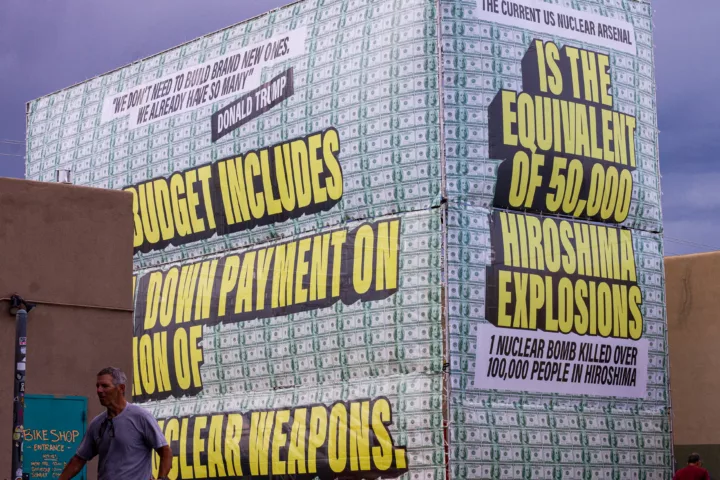On July 23, 2014, Los Alamos National Laboratory approved for public release an article titled Rethinking the Unthinkable, written by retired U.S. Air Force Colonel Houston T. Hawkins, with the intention of being used for public presentations.
This article argues for an increase in nuclear weapons production and expanding stockpiles. Hawkins stresses the importance nuclear weapons has for the stability of U.S. foreign policy, arguing “the march toward disarmament would take us backwards into an even more unstable and dangerous world.” This stability, therefore, is generated by nuclear stockpiles.
In addition, nuclear deterrence according to the article is an important cornerstone of national security in that it serves as “strategic parity” between states. It also yields confidence not only in the functioning of domestic stockpiles, but in the intelligence capability of U.S. decision makers in assessing foreign nuclear advancements and curtailing surprises.
The phrase ‘Rethinking the Unthinkable,’ in this case, is merely a list Hawkins’s reasons for defending nuclear weapons. Nothing new here, despite the misleading headliner that this piece might be ‘rethinking’ the dominant narrative instead of simply reiterating it.
Interestingly enough, the article is preceded by a disclaimer: “Los Alamos National Laboratory strongly supports academic freedom and a researcher’s right to publish; as an institution, however, the Laboratory does not endorse the viewpoint of a publication or guarantee its technical correctness.” But the fact that the Lab did publish this pro-more-nukes piece suggests that, at the very least, LANL approves its basic logic. This disclaimer is especially salient given the recent firing of former LANL employee James Doyle, author of article Why Eliminate Nuclear Weapons – a critique of the political theories bolstering the nuclear arms race. The article was published in the February-March 2013 issue of Survival: Global Politics and Strategy.
Doyle claims that he was fired as a result of the publication of his article. Regardless, the article was originally declassified, which begs the question: Where is the support for “academic freedom and a researcher’s right to publish” in this scenario?
Doyle argues in his article that the risks involved with upholding a nuclear deterrence policy are too great to pursue, going against the grain of what LANL recently published with Hawkins’s article. He focuses his claims on all of the myths that sustain the plausibility of deterrence, and one by one aims to debunk their relevancy. He writes, “deterrence is a complex, tightly coupled system…vulnerable to the unpredictable and uncontrollable nature of human error, mechanical failure and accident.” In addition, the article cites the historical specificity of the Cold War and the grave overlooks involved in trying to translate this ideology to today’s shifting geopolitical landscape. Cooperating transnationally and reducing, if not halting, nuclear weapon production, he argues that we can at least “symbolically improve the chances of successfully addressing other existential threats” such as climate change, food shortages, overpopulation, and environmental degradation.
What’s interesting here are not necessarily the opposing viewpoints on deterrence for their own sake, but rather the light they shed on issues of classification surrounding LANL. Doyle’s article, which was retroactively classified and redacted from public purview (more of a symbolic gesture than anything given its already widespread circulation), was seen as a security threat.
Held up against Hawkins’ piece (which includes seemingly sensitive data such as the age of U.S. nuclear stockpiles in relation to other countries, as well as the amount of certified pits LANL has produced since 1989), it is curious as to what exactly was deemed classified and for what reason. What is LANL’s rubric for classification, and through what means do they determine this?
In fact, U.S. vulnerability and insecurity is littered throughout Rethinking the Unthinkable and is used, rhetorically, as justificatory evidence for expanding U.S. nuclear production.For example, Hawkins references the incredible historical underestimation of the Soviet Union’s nuclear arsenal, illustrated by a graph with numerical data.
There must be some larger current swelling here if LANL is willing, by publishing this article, to publicize U.S. inadequacies to a large and uncontrolled audience. And might this current have something to do with the aftermath of Doyle’s article, an article much more reserved in U.S. impotence and fear mongering? What is being classified here?
Many have speculated that a potential red flag worth classifying is Doyle’s discussion of Israel and its possession of nuclear weapons. However, does this really hold enough gravity given the fact that even a basic and preliminary search demonstrates a widely held belief that Israel has nuclear weapons?
Attention has also been drawn to Doyle’s citations of U.S. misperceptions of Soviet anxiety during the Cold War, including the Able Archer exercise of November, 1983. This exercise has been covered in other published works, including Eric Schlosser’s 2013 book Command and Control, which was researched and written with the help of declassified documents. Again, is Doyle’s article really saying anything radical that deems classification?
Given not only the contradictions between these two articles, but also the fact that one article allegedly resulted in the author getting fired from the Lab and the other article published directly by it, we can begin to see that what Los Alamos deems ‘classified’ is really everything and anything that doesn’t tout a pro-nuclear proliferation message. A message that, of course, keeps budget funding and profits afloat.
– Dion Kauffman

